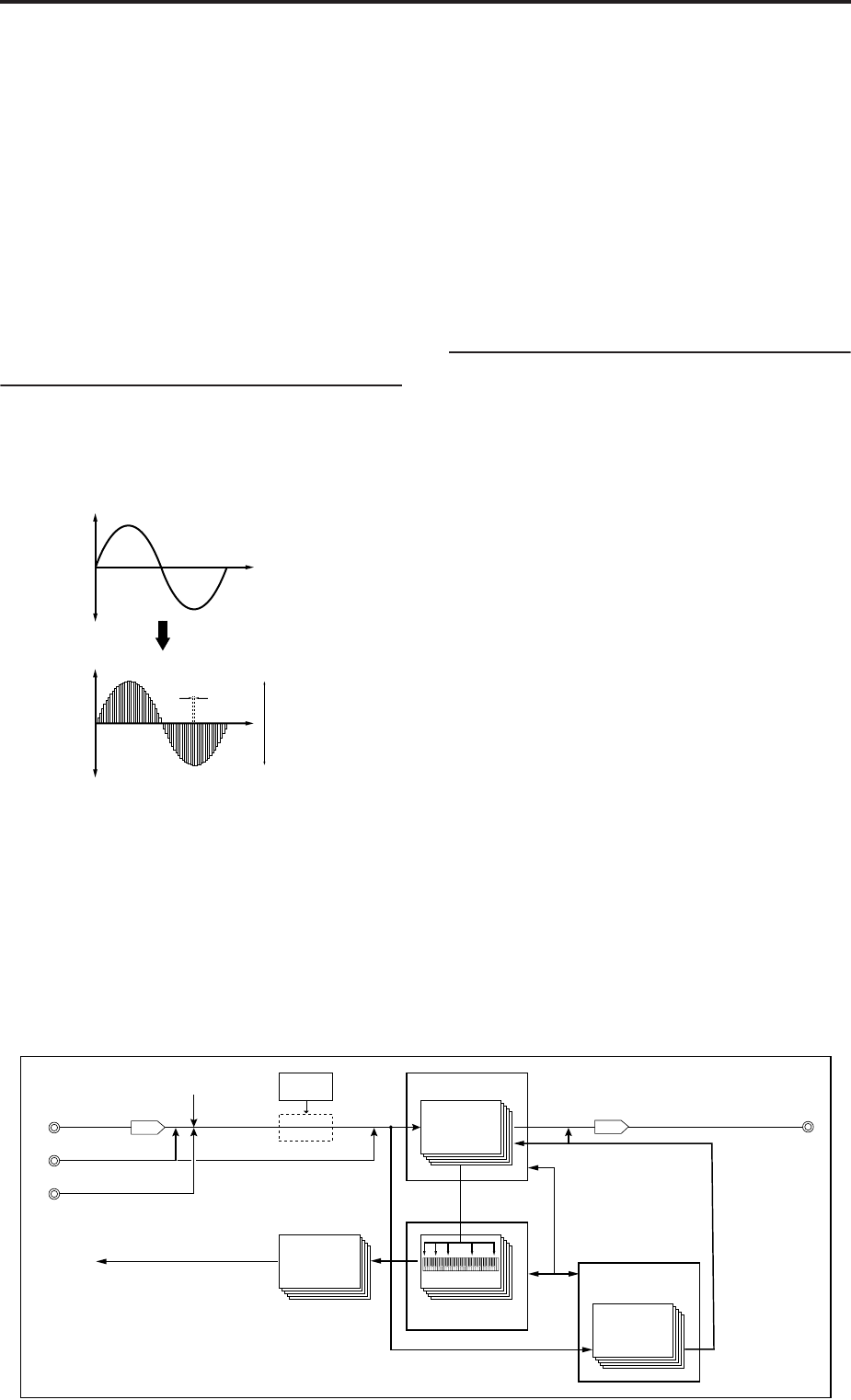
Sampling (Open Sampling System)
120
2) You can sample external audio sources via the
OASYS’ input jacks (see “Sampling mode” 1 and 2,
above). At this time, you can mix the OASYS’ own
performance with the audio signals from the external
source and sample the combined result, or you can
monitor the performance of the OASYS while
sampling only the external source from the input jacks.
3) In Sequencer mode when you sample an external
audio source that’s playing along with the song
playback, note data will be automatically created in a
track to trigger this sample at the appropriate moment
in the song. This means that you can sample your vocal
or guitar performance while playing back the
sequencer. This is called the In-Track Sampling
function.
Sampling frequency and bit resolution
As shown in the diagram, sampling reads the level of
the analog signal at fixed intervals along the time axis,
and stores the levels in memory as digital data.
The “fixed intervals” mentioned above are generally
expressed as the “sampling frequency.” 48 kHz
(kilohertz) means that sampling is performed 48,000
times each second, and that the interval is 1
(second)/48,000 (times) = approximately 0.00002083
(seconds) = approximately 0.02083 mS (millisecond).
The higher the sampling frequency is, the closer to the
original analog signal the waveform in memory will
be.
Each level is read, and converted into digital data. The
accuracy at this time is determined by the bit
resolution. This process converts an analog signal with
infinite resolution into a digital signal with finite
resolution. With 16 bit resolution, each level is
indicated in 65,536 steps (the sixteenth power of two).
The greater the bit resolution is, the closer to the
original analog signal the waveform in memory will
be.
48 kHz 16 bit sampling is the same quality as in audio
devices such as DAT. A CD uses 44.1 kHz 16 bit
sampling, which is a slightly lower sampling
frequency.
How Sampling mode is organized
This section describes how sampling on the OASYS is
organized. (See the diagram below)
Samples and Multisamples
Samples
The data that is recorded (sampled) into internal
memory or loaded from a file is referred to as a sample
or sample file. Samples consist of the actual waveform
data, and parameters that specify how the data will be
played back, such as Start, Loop Start, and End
Address. Samples can be used in multisamples and
drum kits.
The OASYS can hold a maximum of 4,000 samples in
its internal memory.
The OASYS can share a single waveform among
multiple samples. This allows you to create multiple
samples with different playback addresses from the
same waveform without wasting internal memory. For
example, suppose that you have waveform data that
records a voice saying “One-Two-Three.” This single
piece of waveform data could be shared by three
samples, with the playback of sample A producing
“One-Two-Three,” sample B producing “One-Two,”
and sample C producing “Two-Three.”
For more information, see “Copy” on page 624 of the
Parameter Guide.
Sampled digital
waveform
Time
Level
Level
Time
Analog waveform
16 bit
=65,536 levels
of data
48 kHz
= 48,000 times every second
= 0.0208 mS cycle
CD-R/RW Drive Audio Input
(Audio CD)
(Ripping)
ADC
Sample 0000 ... 3999
RAM (memory):
DAC
Insert Effects
(Master Effects)
Disk
Multisample 000 ... 999
AUDIO INPUT jack
Analog/digital
convertor
Analog signal
Analog signal
Digital signal
Used by combinations
and songs
Resampling
Program, combinations and
songs
AUDIO
OUTPUT
jack
RAM (internal memory)
WAVE File
Digital/analog
convertor
Analog signalDigital signal
Program
Conceptual diagram of the Open Sampling System
